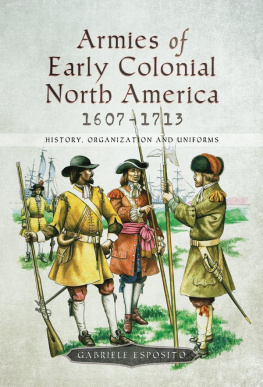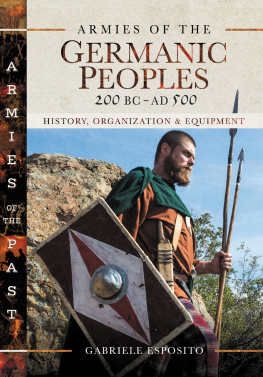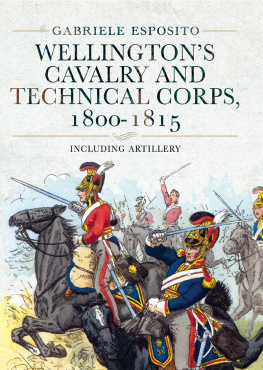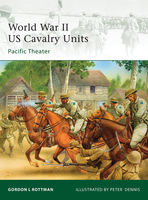Wellingtons Infantry
Wellingtons Infantry
British Foot Regiments 18001815
Gabriele Esposito
First published in Great Britain in 2021 by
Pen & Sword Military
An imprint of
Pen & Sword Books Ltd
Yorkshire Philadelphia
Copyright Gabriele Esposito 2021
ISBN 978 1 52673 029 9
eISBN 978 1 52678 668 5
Mobi ISBN 978 1 52678 669 2
The right of Gabriele Esposito to be identified as Author of this Work has been asserted by him in accordance with the Copyright, Designs and Patents Act 1988.
A CIP catalogue record for this book is available from the British Library
All rights reserved. No part of this book may be reproduced or transmitted in any form or by any means, electronic or mechanical including photocopying, recording or by any information storage and retrieval system, without permission from the Publisher in writing.
Pen & Sword Books Limited incorporates the imprints of Atlas, Archaeology, Aviation, Discovery, Family History, Fiction, History, Maritime, Military, Military Classics, Politics, Select, Transport, True Crime, Air World, Frontline Publishing, Leo Cooper, Remember When, Seaforth Publishing, The Praetorian Press, Wharncliffe Local History, Wharncliffe Transport, Wharncliffe True Crime and White Owl.
For a complete list of Pen & Sword titles please contact
PEN & SWORD BOOKS LIMITED
47 Church Street, Barnsley, South Yorkshire, S70 2AS, England
E-mail:
Website: www.pen-and-sword.co.uk
Or
PEN AND SWORD BOOKS
1950 Lawrence Rd, Havertown, PA 19083, USA
E-mail:
Website: www.penandswordbooks.com
Gabriele Esposito is a military historian who works as a freelance author and researcher for some of the most important publishing houses in the military history sector. In particular, he is an expert specializing in uniformology: his interests and expertise range from the ancient civilizations to modern post-colonial conflicts. During recent years he has conducted and published several researches on the military history of the Latin American countries, with special attention to the War of the Triple Alliance and the War of the Pacific. He is among the leading experts on the military history of the Italian Wars of Unification and the Spanish Carlist Wars. His books and essays are published on a regular basis by Osprey Publishing, Winged Hussar Publishing and Libreria Editrice Goriziana; he is also the author of numerous military history articles appearing in specialized magazines like Ancient Warfare Magazine, Medieval Warfare Magazine, The Armourer, History of War, Guerres et Histoire, Focus Storia and Focus Storia Wars .
Acknowledgements
T his book is dedicated to my parents, Maria Rosaria and Benedetto, for all the great support that they give me during the creation of my books. Thanks to their precious advice of veteran teachers, my researches are clearly much better. A very special thanks goes to Philip Sidnell, the commissioning editor of my books for Pen & Sword: this new series, which starts with the present book, exists thanks to his great intelligence and positive vision. Everything began with a simple idea, during a very hot summer: now that project is coming to fruition. Last but not least, a special mention goes to the production manager of this title, Matt Jones, for his great competence. All the pictures published in this book are public domain ones obtained from the magnificent Digital Collections of the Brown University Library, in particular from the incredible Anne S.K. Brown Military Collection. The vast contents of the latter can be easily browsed at: https://library.brown.edu/info/collections/askb/prints/
Introduction
T he main aim of this book is to present a detailed overview of the organization, uniforms and equipment of the British infantry during the Napoleonic Period. The period taken into account in the present work coincides with one of the most glorious moments in the military history of Britain, during which the British Army fought around the globe to counter the expansionist ambitions of Napoleon and his newly established French Empire. After the Peace of Amiens was broken in 1803, Great Britain found itself at war with an old enemy (France), but also with a new competitor (Napoleon): the latter was the greatest military commander of his times, a man who was able to transform the French Army into the most lethal fighting machine of the early nineteenth century. The war experiences of 17931803 had not been very positive ones for the British Army, which was still recovering from the crushing defeats suffered during the American War of Independence and badly needed to be reformed in order to become more efficient and modern. At the turn of the new century, Britain was still the greatest colonial power in the world and could count on the most formidable navy in the world; on land, however, its army was too weak to confront the French on anything like equal terms. The British land forces did not have a great leader comparable to Napoleon and were still influenced by tactical models that had been outclassed by events. During the Napoleonic Wars, the British military apparatus did its best to improve, especially under the guidance of intelligent officers who belonged to a new generation. These innovative and capable men reformed the British Army by improving its standards of service and creating a new relationship based on mutual trust with the men under their command. Wellington was the greatest of these officers, one of the few European generals who had the personal capabilities to take on Napoleon in an effective way: it was he who forged the new British Army by fighting against the French in the Iberian Peninsula from 180814. After learning from experience, the British soldiers were finally able to face Napoleon over the Belgian fields of Waterloo and thus write the last page of a glorious military epic. Waterloo, however, was just the final result of a long process. During the period from 180015, in fact, British officers had to completely reform the tactical and operational patterns of their units: for example, a real light infantry revolution took place among the ranks of the foot troops. All this was an experimental process, which sometimes led to bad results. The glorious actions of the Peninsula, indeed, were not the only ones fought between 1800 and 1815. We should not forget, for example, the three campaigns conducted in the Netherlands (1799, 1809 and 1814), which were disasters for the British Army.
To follow the evolution of the British Army during the Napoleonic Period, we have divided the text into twelve chapters. The first one will deal with the elite of the British infantry, the three regiments of Foot Guards, while the second will analyze the general organization of the line infantry, with its 104 Regiments of Foot serving during the Napoleonic Wars. The third chapter will be devoted to the Scottish troops (both Highlanders and Lowlanders), since they had many distinctive features, and the fourth will focus on the light infantry and will reconstruct the crucially important light infantry revolution mentioned above. The fifth chapter will deal with two little-known categories of foot troops which had important roles in static defence: the Royal Veteran Battalions and the Fencible Regiments. The sixth chapter will reconstruct the British military presence in Canada, an area where the War of 1812 against the United States took place, while the seventh will analyze the British military units deployed in the crucial region of the West Indies, where several actions were fought against the French. The eighth will discuss the British military presence in the early colonies of Africa and Australia, where Great Britain was still struggling to establish permanent settlements, and the ninth will describe the military forces of the East India Company, which were not part of the regular British Army but which fought for the commercial interests of the Crown in India. The tenth chapter will cover all the foreign troops serving in the British Army during the Napoleonic Wars, the eleventh will deal with the most formidable of the latter, the Kings German Legion, and the last chapter will describe the uniforms and equipment employed by all the categories of foot troops covered in the previous chapters.














